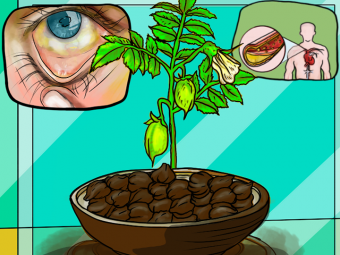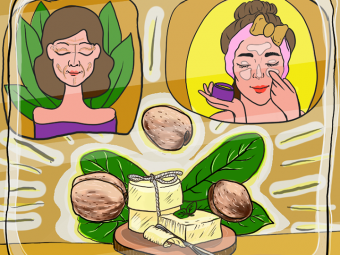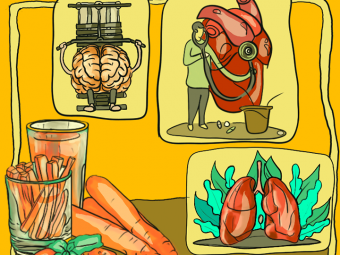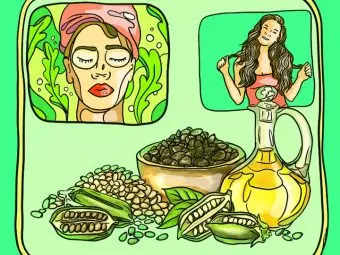For many people, chocolates are bliss and a blessing. Where does this pure bliss come from? It is cacao beans. The benefits of cacao beans are often misunderstood as that of chocolate, but it is the other way around.
So, how do cacao beans benefit your health? Well, they help nurture the skin, promote hair growth, improve memory, and reduce the risk of CVD, obesity, and inflammation. But are these claims scientifically backed?
In this article, we look into the scientific basis of these claims, what cacao beans are, how they are processed, their nutritional profile, whether cocoa is the same as cacao, and more. So, let’s get started!
In This Article
Cacao: Up Close
Cacao (Theobroma cacao), pronounced as ka-KA-oh, is a tropical tree native to the forests of Central America. It bears ribbed, thick-skinned fruits called cacao beans. These beans grow directly from the trunks and larger branches of the tree.
Cacao bean pods have 35-50 almond-like seeds, which have shells, separated by sweet-tasting pulp. The seeds are processed to get the cacao powder, with which dark chocolate is made.
Archaeologists found evidence of cacao dating back to 1900-1500 BC. The Aztecs used cacao seeds as currency. At places they didn’t grow, cacao beans were luxury. These beans were processed to prepare sweet, frothy, and refreshing drinks, especially in Mexico (1).
Now, coming to the pertinent question – how is cacao different from cocoa? For this, you need to understand the traditional processing of the cacao beans.
Scroll down!
How Is Cacao Processed?

Shutterstock
Step 1: Cacao seeds and the surrounding fruit pulp are typically placed in heaps or boxes for natural fermentation. In this step, the naturally occurring microbes multiply using the sugar from the pulp as an energy source.
Step 2: The seeds are then dried in the sun or wood-fired ovens and shipped to cacao processors.
Step 3: The thin coats of the seeds are separated from the inner embryonic tissue. These naked seeds are then roasted and milled to form chocolate liquor.
Now comes the best part!
Step 4: By mechanically pressing most of the fat (cocoa butter) from the chocolate liquor, the crude and most loved cocoa powder is produced (2).
Trivia Time!
- Cacao are the seeds that are processed to give a refined extract called cocoa powder.
- Chocolate is a solid food made by combining cocoa liquor with cocoa butter and sugar.
- The proportion of cocoa liquor in the final product determines how dark the chocolate is.
- Milk chocolate is made with the addition of condensed or powdered milk to the chocolate mixture – which typically contains 10–12% cocoa liquor.
- Semisweet or bittersweet chocolate is often referred to as dark chocolate, and it contains no less than 35% of cocoa liquor by weight.
- White chocolate contains only cocoa butter combined with sweeteners and dairy ingredients.
We binge on chocolates matter-of-factly. But look at the process that needs to be followed to get a slab of chocolate. No wonder it is a multibillion-dollar industry, employing thousands of civilians!
All this is great to know. But how does it matter to your health? Why should you eat some bittersweet, fermented extract of a random tropical bean pod?
The answer lies in the chemical composition of the cacao beans. Let’s learn some science now!
What Makes Cacao Or Cocoa Beneficial For Health?
Cacao nibs or the raw cocoa extracts contain relatively high concentrations of polyphenols, lipids, minerals, vitamins, and fiber.
Flavanols are the class of polyphenols that are predominantly present in cocoa liquor. Flavanols, especially epicatechin, catechin, quercetin, caffeic acid, and proanthocyanidins, can act as strong antioxidants.
Cacao nibs and cocoa powder also have theobromine and caffeine that have various physiological effects.
Essential minerals like magnesium, copper, potassium, and iron are also abundant in cacao and cocoa powder. Check this out for the numbers:
| Nutrition Facts Serving Size 100g | ||
|---|---|---|
| Amount Per Serving | ||
| Calories 228 | Calories from Fat 115 | |
| % Daily Value* | ||
| Total Fat 14g | 21% | |
| Saturated Fat 8g | 40% | |
| Trans Fat 0 g | ||
| Cholesterol 0mg | 0% | |
| Sodium 21mg | 1% | |
| Total Carbohydrate 58g | 19% | |
| Dietary Fiber 33g | 133% | |
| Sugars 2g | ||
| Protien 20g | ||
| Vitamin A | 0% | |
| Vitamin C | 0% | |
| Calcium | 13% | |
| Iron | 77% | |
| Calorie Information | ||
| Amounts Per Selected Serving | %DV | |
| Calories | 228(955 kJ) | 11% |
| From Carbohydrate | 77.4(324 kJ) | |
| From Fat | 115(481 kJ) | |
| From Protein | 35.9(150 kJ) | |
| From Alcohol | 0.0(0.0 kJ) | |
| Carbohydrates | ||
| Amounts Per Selected Serving | %DV | |
| Total Carbohydrate | 57.9 g | 19% |
| Dietary Fiber | 33.2 g | 133% |
| Starch | ~ | |
| Sugars | 1.8 g | |
| Fats & Fatty Acids | ||
| Amounts Per Selected Serving | %DV | |
| Total Fat | 13.7 g | 21% |
| Saturated Fat | 8.1 g | 40% |
| Monounsaturated Fat | 4.6 g | |
| Polyunsaturated Fat | 0.4 g | |
| Total trans fatty acids | ~ | |
| Total trans-monoenoic fatty acids | ~ | |
| Total trans-polyenoic fatty acids | ~ | |
| Total Omega-3 fatty acids | ~ | |
| Total Omega-6 fatty acids | 440 mg | |
| Protein & Amino Acids | ||
| Amounts Per Selected Serving | %DV | |
| Protein | 19.6 g | 39% |
| Vitamins | ||
| Amounts Per Selected Serving | %DV | |
| Vitamin A | 0.0 IU | 0% |
| Vitamin C | 0.0 mg | 0% |
| Vitamin D | ~ | ~ |
| Vitamin E (Alpha Tocopherol) | 0.1 mg | 1% |
| Vitamin K | 2.5 mcg | 3% |
| Thiamin | 0.1 mg | 5% |
| Riboflavin | 0.2 mg | 14% |
| Niacin | 2.2 mg | 11% |
| Vitamin B6 | 0.1 mg | 6% |
| Folate | 32.0 mcg | 8% |
| Vitamin B12 | 0.0 mcg | 0% |
| Pantothenic Acid | 0.3 mg | 3% |
| Choline | 12.0 mg | |
| Betaine | ~ | |
| Minerals | ||
| Amounts Per Selected Serving | %DV | |
| Calcium | 128 mg | 13% |
| Iron | 13.9 mg | 77% |
| Magnesium | 499 mg | 125% |
| Phosphorus | 734 mg | 73% |
| Potassium | 1524 mg | 44% |
| Sodium | 21.0 mg | 1% |
| Zinc | 6.8 mg | 45% |
| Copper | 3.8 mg | 189% |
| Manganese | 3.8 mg | 192% |
| Selenium | 14.3 mcg | 20% |
| Fluoride | ~ | |
I’ve been going on and on that cacao is good for health and promotes well-being. But how does it exactly do so? What are the benefits of having cacao or its extracts? Read on to find out!
What Are The Benefits Of Cacao?
1. Nurtures Your Skin

Shutterstock
Cacao and its derivatives (like cocoa powder and dark chocolate) are rich in flavanols like epicatechin, catechin, epigallic acid, caffeic acid, and theobromine.
These compounds scavenge the free radicals generated, particularly in your skin, due to UV and visible light exposure. Dark chocolate has an anti-aging effect as well as anti-inflammatory and antioxidant properties. It has shown to reduce erythema and skin cancers by about 25%.
Topical application of cocoa butter can reduce wrinkles, fine lines, dark spots, pimples, blemishes, and breakouts on your skin (3).
2. Boosts Hair Growth And Repair
Magnesium plays a vital role in cell division and growth. It is responsible for anti-inflammatory and repair mechanisms in the cells, especially in the hair follicles.
Consuming cacao or cocoa powder can boost hair growth from the roots, more so after menopause. It also prevents inflammation that influences your hair health and growth patterns (4).
3. Protects And Promotes Dental Health

Shutterstock
Contrary to belief, chocolates are good for your teeth – but not the sweet ones.
Research says that unsweetened cocoa, dark chocolate, and chocolate liquor contain inhibitors of the dextransucrase enzyme, which is responsible for the formation of the plaque on your teeth.
Also, cacao products have an anticaries effect – they prevent any microbial growth in the teeth and gums. Cocoa-enriched diets can cure periodontitis and infections like gingivitis (5).
Subscribe
4. Fights Obesity And Lipid Peroxidation
In a rat study, a cocoa-rich diet resulted in a loss of weight and reduction in obesity-related inflammation and triglyceride accumulation.
Cacao has anti-hyperlipidemic activity and prevents lipid peroxidation. Since it is rich in antioxidants, making cocoa a part of your diet can reduce levels of ROS (reactive oxygen species) in your body. This means no inflammation of the organs, particularly the liver and blood vessels.
In another trial, consumption of 100 g flavonoid-rich chocolate over two weeks reduced total serum cholesterol by 7% and LDL by 12% (6).
Cocoa also alters the expression of genes that promote obesity and inflammation. So, in all aspects, cacao ensures that obesity and related complications are kept at bay (7).
5. Prevents Cardiovascular Diseases (CVDs)

Shutterstock
Increased levels of free radicals, LDL (bad cholesterol), and heavy metal ions, paired with reduced nitric oxide (NO) availability and HDL levels, can trigger cardiovascular diseases.
The polyphenolic ingredients in cacao, such as procyanidins, flavanols, and caffeine derivatives, work wonders for your heart health. These bioactive ingredients lower hypertension, scavenge free radicals, and boost HDL levels in your plasma.
The blood vessels and smooth muscles work better in the presence of cocoa because the bioavailability of nitric oxide (NO) is enhanced. In similar mechanisms, chocolate can keep you safe from fatal cardiovascular diseases like atherosclerosis, coronary artery disease, hypertension, angina, etc. (8).
6. Improves Cognition And Memory
The antioxidant properties of catechin, quercetin, and epicatechin derivatives present in chocolate liquor can prevent neuronal injury and neuroinflammation. These phytochemicals are involved in the formation of long-term memory.
Cocoa can also induce new nerve cell growth and increase blood flow in your brain – both of which can be neuroprotective.
The effects suggest that chocolate and its precursors can manage dementia, stroke, Alzheimer’s, and Parkinson’s disease effectively (6).
Did You Know?
- Unsweetened cocoa has a neurostimulatory effect. It can uplift your mood, memory, and sleep cycle.
- This is why it is said that dark chocolate is healthier than the sweetened or milk chocolate.
- Cocoa is treated with alkali to improve the flavor and appearance. However, this causes a significant loss of flavanols. Natural cocoa, found in the baking aisle, retains the most flavanols.
7. Reduces And Manages Inflammation
Making cocoa a habit can reduce the production of pro-inflammatory chemicals in your body, according to researchers.
Theobromine, caffeic acid, catechin, epicatechin, procyanidins, magnesium, copper, and other active constituents in cacao derivatives fight inflammation by reducing the activation of immune system cells, mainly monocytes and macrophages (9).
Having foods rich in cocoa can prevent and cure chronic inflammatory disorders, namely, irritable bowel disease (IBD), asthma, Alzheimer’s, dementia, periodontitis, GERD, and various cancers.
After reading about the benefits of cacao, cocoa powder, and unsweetened chocolate, I was in awe of how nature packs all the phytochemicals into such small (and bitter tasting) cacao nibs.
What’s The Take Home?
As I said, chocolate is pure bliss to me. But now, after knowing more about cacao, chocolate has become more than precious to me.
The science and art that go into making chocolate from the bright cacao beans and the scale of this industry show how significant cacao has been across civilizations.
Did you ever imagine that the bittersweet dark chocolate can uplift your mood, heal your wounds, protect your vital organs, build bones, and improve your memory as well?
I’m sure, no. It almost sounds like an all-cover medical insurance plan!
So, add a slab of pure 70-85% dark chocolate to your shopping cart right away. Make sure that you have at least two tiles of the dark chocolate every day. See the results for yourselves!
The benefits of cacao include its physiological effects, thanks to its caffeine and theobromine content. Cacao and its derivatives may help fight free radicals in the skin and prevent premature aging. Consuming it may also result in healthier hair growth. Cacao may also help reduce the risk of cardiovascular disease besides helping manage dementia, stroke, Alzheimer’s, and Parkinson’s. It may also help reduce cholesterol and have an anti-obesity effect. So, consume a minimum of two tiles of dark chocolates daily to uplift your mood and to make the most of its disease-protecting properties. As with any food, consuming chocolate excessively can be counterproductive, so moderation is the key.
Frequently Asked Questions
Can I drink cacao at night?
No. Cacao is a natural stimulant due its theobromine content (which increases heart rate and causes sleeplessness) (10).
Is cacao healthier than coffee?
Yes. Cacao is healthier than coffee due to the presence of theobromine. It can dilate blood vessels instead of shrinking them.
What has more caffeine: coffee or cacao?
Coffee has more caffeine than cacao. One cup of brewed cacao may contain 24 mg of caffeine, which is 25 percent of the amount of caffeine (80-100 mg) found in coffee.
Does cacao cause insomnia?
Yes. Although cacao contains a small amount of caffeine compared with coffee, it still causes insomnia in people sensitive to caffeine.
Is 100 percent cacao good for you?
Yes, 100 percent cacao contains protective antioxidants with many health benefits. It helps treat many ailments when consumed in moderation.
Sources
Articles on StyleCraze are backed by verified information from peer-reviewed and academic research papers, reputed organizations, research institutions, and medical associations to ensure accuracy and relevance. Read our editorial policy to learn more.
- “Cacao, Cocoa, and Chocolate” University of California, San Diego
- “Cacao seeds are a “Super Fruit” Chemistry Central Journal, US National Library of Medicine
- “Cocoa Bioactive Compounds: Significance…” Nutrients, US National Library of Medicine
- “Nutrition of women with hair loss problem…” Menopause Review, US National Library of Medicine
- “Cocoa Polyphenols and Their Potential..” Oxidative Medicine and Cellular Longevity, US National Library of Medicine
- “Cocoa and Chocolate in Human Health…” Antioxidants and Redox Signaling, US National Library of Medicine
- “Dietary cocoa ameliorates obesity…” European Journal Of Nutrition, US National Library of Medicine
- “Cocoa, chocolate and cardiovascular disease” Journal of Cardiovascular Pharmacology, US National Library of Medicine
- “Impact of Cocoa Consumption on…” Nutrients, US National
- “UHPLC-HRMS Analysis of Theobromine in Theobroma cacao and its Products”, Journal of Nutrition & Food Sciences.
Related
The following two tabs change content below.
- Author
- Reviewer
Swathi Handoo
Swathi holds a master’s degree in biotechnology and has worked in places where actual science and research happen. She has… more
Anna Jones
(MS, RD, LD/N)Anna is a Registered Dietitian who is truly passionate about helping people make healthy, lasting lifestyle changes through balanced, nutrient… more



 29 Amazing Benefits Of Figs For Skin, Hair And Health
29 Amazing Benefits Of Figs For Skin, Hair And Health 19 Amazing Benefits Of Black Chickpeas (Kala Chana) For Skin, Hair And Health
19 Amazing Benefits Of Black Chickpeas (Kala Chana) For Skin, Hair And Health 28 Best Shea Butter Benefits For Skin, Hair And Health
28 Best Shea Butter Benefits For Skin, Hair And Health 15 Best Benefits Of Beta Carotene For Skin, Hair And Health
15 Best Benefits Of Beta Carotene For Skin, Hair And Health 29 Amazing Benefits Of Sesame Seeds For Skin And Health
29 Amazing Benefits Of Sesame Seeds For Skin And Health 4 Reasons Goat Cheese Is Better Than Cow Cheese
4 Reasons Goat Cheese Is Better Than Cow Cheese 38 Benefits Of Lime For Skin, Hair, And Health + Nutrition
38 Benefits Of Lime For Skin, Hair, And Health + Nutrition Rice Water For Skin – How To Use It For Maximum Benefits
Rice Water For Skin – How To Use It For Maximum Benefits 9 Benefits Of Cranberry Tea For Health And Recipes To Try
9 Benefits Of Cranberry Tea For Health And Recipes To Try